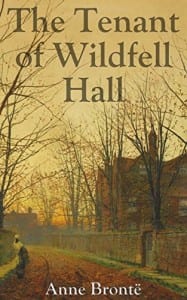Book Review: The Tenant of Wildfell Hall by Anne Brontë.
Jamie Watts: English Studies
The Tenant of Wildfell Hall is undoubtedly a masterpiece. I think it far outshines Wuthering Heights and is equal to Vilette and Jane Eyre in its accomplishments. In fact I often wonder if Charlotte Bronte’s decision to suppress the publication of this book after Anne died was motivated more from a place of jealousy than any moral concerns about propriety.

The Tenant of Wildfell Hall was Anne Brontë’s second novel, first published in 1848 under the pseudonym Acton Bell.
Anne Bronte writes frankly and openly about conditions affecting (admittedly middle class) women in Victorian England with no legal rights to property or, should their marriage fail, their child. The main character, Helen Graham, marries for ‘love’ rather than a suitor her de facto parents find suitable, which is also a change from earlier Regency writing such as Jane Austen. However, Arthur Huntingdon is a swine – cheating, gambling, drinking, he is an utterly loathsome man. Helen begs him to allow her to leave when he takes up with Lady Lowborough but Huntingdon refuses, this motivates Helen to flee with her child to help his moral upbringing.
Having read this book six years ago it has lost none of its lustre, the story is observed by Gilbert Markham who is besotted with Helen. He first believes village gossip that she is sleeping with Mr Lawrence but it later transpires that he is Helen’s brother and he is helping her. She makes a living from her art so Bronte is concerned with the female as artist. Ultimately Helen must do what is good and she returns to nurse Huntingdon when he is ill. Suddenly and unexpectedly (same thing happens in Jane Eyre and defies logic) Helen inherits vast wealth, Arthur Huntingdon dies and she is able to marry Markham. For a novel of 600 pages most of this happens in about the last five, so the ending feels rushed but I think I’m correct in thinking Anne was taken ill and does not long after this novel came out. For a Victorian novel it is so accessible and easy to read and I think it’s such a shame Anne isn’t regarded as well as Emily or Charlotte.
Anne Brontë’s The Tenant of Wildfell Hall is covered on the optional module ‘The Ninteenth-Century Woman Writer’.
Jamie is currently studying an MA in English Studies. Have you also read this novel? Let us know what you thought in the comments or on our social media platforms.
